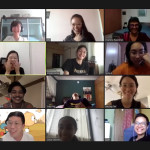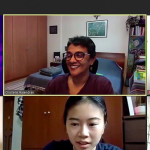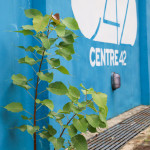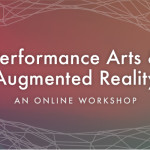![[From top left, clockwise] Woo E-Hui, Cheryl Tan Yun xin, and Derrick Chew, participants of the “Performance Arts and Augmented Reality” online workshop.](images/arworkshopinterview_1000px.jpg)
[From top left, clockwise] Woo E-Hui, Cheryl Tan Yun xin, and Derrick Chew, participants of the “Performance Arts and Augmented Reality” online workshop.
What is your role in the theatre?
Cheryl: My background is in acting, but I also like to explore making works, especially works that will enrich people of different races, age, and abilities. My current interest is in creating participatory works, and I am a part of ATTEMPTS.
E-hui: I am primarily a lighting designer, but I occasionally take on roles in electrics, technical management, stage management, and whatever else comes along in my trajectory that excites me!
Derrick: I am the executive producer of Sightlines Entertainment, where we produce immersive theatrical experiences that excite, entertain and educates. But I have also done everything else from management to marketing and directing.
What is your level of comfort and relationship with working with technology in art-making?
Cheryl: I love using technology! I am someone who likes to explore the options I can add to a production to make it better or even cooler, so I love adding lots of sounds, lights and projection. We’re also surrounded by technology, so to avoid using it just seems quite unnatural.
The ironic thing is, even though I love technology, most days, technology doesn’t love me back. I am a 电脑白痴 [Chinese for “tech idiot”]. That’s why I wanted to take the course, to get myself more familiar with new technology.
E-hui: As a lighting designer and programmer, most of my art-making includes the use of technology in order to bring ideas to life, so I always appreciate new opportunities to try out new technological advancements. With everything becoming increasingly digital these days, I think the new age of “digital theatre” is almost necessary to incorporate in order to stay in touch with our up and coming generation of patrons.
Derrick: I am really not a “techie”, but I am very comfortable with technology and very open to using it in my work because I believe it is the future. I also turn to technology as a way to develop new audiences that are not usually the kind who go to the theatre.
Could you share a few key concepts and thinking points from the workshop that you resonated with? Why did it have an impact on you?
Cheryl: I think the biggest takeaway for me was realising how easy the technologies can be. It was as easy as using a mobile application and a print-out. I always thought it would involve high technology that I don’t have [access to]. But to know that I could do a simple [photogrammetry] capture so easily myself and play around with it, impressed and inspired me.
E-hui: My favourite sharing was about how digital realities could manipulate time and space, because these are two REALLY weird concepts right now [in the COVID-19 pandemic]. I think everyone feels stuck right now because of the pandemic, whether it’s at home or in their career or back in April (I’m not sure how we got to August already!). This was a “hot take” that made me think about how organisations can think outside the box when it comes to staying connected with their audiences. So, even though theatre is very much about living, breathing performances, we should always consider new ways of presentation and how we can deliver our work to the rest of the world.
Derrick: I really resonated with what Shou Chen said about having to ask the question, “How does the technology help in my work and my practice?” We shouldn’t jump on it just because it’s on trend. We need to ask how the technology can elevate, support and form a crucial part of the message of an experience.
Is there anything about these new technologies you still find challenging?
Cheryl: I feel as artists, we often lack [safe] spaces in which we can adopt, test and push these kinds of technologies — and fail. But now’s the best time to experiment, when the rules for performance are changing, and maybe digital theatre, or technological theatre can stay on long after the pandemic, instead of just being a replacement.
I also think the first step is not to fear new technologies. Before the workshop, I thought, “I’m going to learn about the technology, but can I really use it?” But I realised the difference is how you choose to approach the terminology, which you can use to bridge the gap. For example, instead of saying “Hey, let’s use AR [Augmented Reality]”, what if I said “Hey, let’s use Snapchat filters”? The start of the conversation already changes a great deal.
E-hui: The cost is definitely one hurdle. The other thing is the knowledge that the more technology you include into your work, the more factors you introduce into the production that do not have the ability to “improvise” or ensure that “the show must go on” in the event that a small cog in the system fails.
I think that in some ways, AR/VR/MR [Augmented Reality/Virtual Reality/Mixed Reality] allows us to reach out to a greater group of audience, but the human presence and being in the space where the magic comes to life are not things that can be replicated with technologies. It can be a useful exploration or placebo (in these weird times), but until these technologies becomes seamlessly integrated into society, I think the human-to-human connection in a live performance still has tremendous merit over just the visual of someone appearing in front of you.
Derrick: I think I still lack a sense of the possibilities of how AR can be used in theatre and performance. That said, I think we are all making up the rules as we go along; there is no structure, methodology or language for AR in performing arts as of yet, in my opinion. But that’s exciting. That’s fun, because we can be the pioneers at the frontier of seamlessly incorporating these technologies into our theatre-making.
I strongly believe that even as artists, we cannot use the methods of yesterday to compete in the economies of tomorrow. So even though I love the live audience element and the sharing energy in the theatre, in times like these, I’m keen to explore how we can evolve and create theatrical experiences in the language of the digital, so that new generations of audiences with new ways of consuming information and entertainment, can be nurtured.
By Lee Shu Yu
Published on 31 Aug 2020
Performance Arts and Augmented Reality was an online workshop facilitated by Tan Shou Chen and Timothi Lim (The Doodle People). Held on 28 Jul, 30 Jul and 4 Aug 2020, 17 performance-makers and production designers were exposed to the potentialities of photogrammetry and volumetric video capture technologies in performance. The workshop was developed by The Doodle People and commissioned by the National Arts Council Singapore. For more information, click here.





